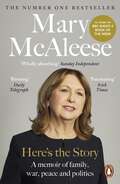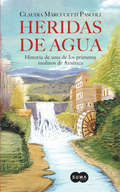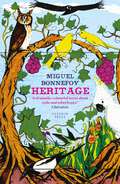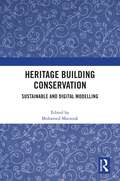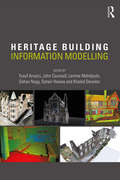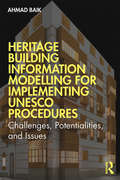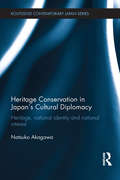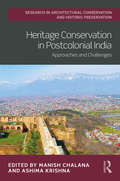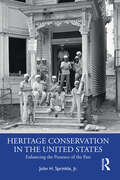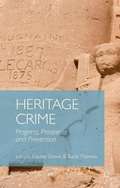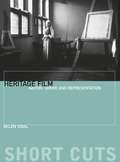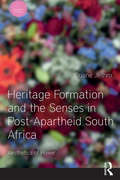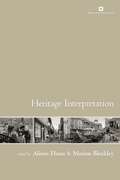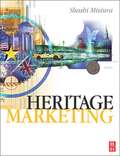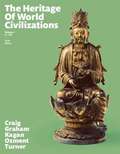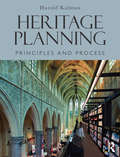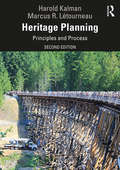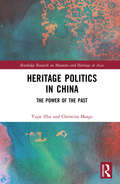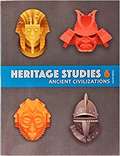- Table View
- List View
Here’s the Story: A Memoir
by Mary McAleeseThe groundbreaking two-term President of Ireland tells the stories of her lifeWhen a young Mary McAleese told a priest that she planned to become a lawyer, the priest dismissed the idea: she knew no one in the law, and she was female. The reality of what she went on to achieve - despite those obstacles, and despite a sectarian attack that forced her family to flee their home - is even more improbable.In this luminous memoir, Mary McAleese traces that astonishing arc: from the tight streets of north Belfast, to a professorship in Dublin while still in her twenties, behind-the-scenes work on the peace process, and two triumphant terms as President of Ireland. She writes of her encounters with prime ministers, popes and royalty with the same easy candour and intimacy with which she describes her childhood. And her account of the latest act in her remarkable career - quietly pursuing a doctorate, and loudly opposing the misogyny of the Catholic Church - is inspiring.Here's the Story is warm, witty, often surprising and relentlessly fascinating: an extraordinarily intimate memoir by one of the most remarkable public figures of our time._______________'A fascinating story and well worth the read' Irish Times'Riveting ... A fiercely urgent reminder to the world - and the Government - that peace must never be sacrificed for politics' Telegraph 'Excellent' Matt Cooper, Irish Daily Mail'I was enthralled and absorbed by this memoir' Sunday Independent'What an incredible life lived by an outstanding role model. I ate this book up' Sinéad Moriarty'Full of conviction and isn't afraid of plain speaking ... Priests, popes, paramilitaries and Ian Paisley are all held to account' Herald Scotland '[A] chatty, provocative and embraceable biography' RTÉ Guide
Heridas de agua
by Claudia Marcucetti PascoliUna novela de amor y desamor, traiciones y lealtades en la que la historia se repite cíclicamente. Tras conquistar la mítica Tenochtitlan y fundar la que llegaría a ser la esplendorosa Ciudad de los Palacios, Hernán Cortés mandó a construir el molino de Santo Domingo, uno de los primeros del continente americano. Levantado sobre las ruinas de un antiguo templo prehispánico, el molino se convirtió en testigo de los secretos, los sueños y las ilusiones de quienes lo habitaron. En el siglo XIX, Gioconda Cattaneo, una joven italiana con espíritu rebelde, inquieto e independiente, se casa con un conde mexicano y viaja a la Ciudad de México, que ella imagina exótica, llena de colorido, vida y paisajes fantásticos. Cuando conoce el molino de Santo Domingo, Gioconda siente que ha encontrado el sitio de sus sueños, así que decide vivir en él; en ese mismo lugar, ella muere en circunstancias poco claras que despiertan sospechas. ¿Se trató de un suicidio o fue un asesinato? Desde entonces, el fantasma de Gioconda se apropia del lugar con más fuerza de lo que lo hizo en vida, mientras intenta aclararse a sí misma cómo terminaron sus días. Del lado de los vivos, encontramos a los personajes que se entrelazan con la historia de Gioconda: su esposo José Crescencio, un noble venido a menos que se convierte en un yugo que ella debe quitarse de encima para cumplir con lo que anhela; José Yves Limantour, el flamante ministro del gobierno de Porfirio Díaz, con quien sostiene una relación en la que tienen igual relevancia la pasión y la conveniencia; Fortunato Immana, un entrañable migrante italiano a quien Gioconda conoce azarosamente, de clase trabajadora, que participa en los movimientos obreros y las huelgas que sacudieron al país en aquella época de grandes cambios sociales.
Heritage
by Miguel BonnefoyA pocket-sized family saga from the rich imagination and storytelling talents of Franco-Venezuelan author Miguel Bonnefoy.A winegrower ruined by the Great French Vine Blight takes his one surviving vine stock and boards a ship for California. But the new life he has in store is not the one he had imagined - taken ill aboard ship, he is forced to disembark at Valparaíso, where a misunderstanding at the customs post finds him rebaptized after his birthplace, Lons-le-Saunier: the Lonsonier family is born in Chile.Making the journey in reverse, his sons return to defend the motherland in 1914, and the ghosts of the war live on across the Atlantic, in a house with three lemon trees and a garden filled with birds, for years to come.From the depths of the trenches to the soaring peaks of the Andes and the shadow of dictatorship, the personal stories of the Lonsoniers collide with key moments in a century of global history, painting a vivid picture of what is both gained and lost through migration. This pocket-sized family saga confirms the rich imagination and storytelling talents of exciting young author Miguel Bonnefoy.
Heritage Building Conservation: Sustainable and Digital Modelling
by Mohamed MarzoukThis book provides a holistic perspective on the sustainable conservation of heritage buildings through outlining the factors that influence the preservation, operational performance and maintainability of heritage buildings and the application of new methodologies and technologies. Using real cases from Egypt, a country which comprises a vast number of unique heritage structures, each of which is deteriorating at its own pace, this book presents a systematic, data-based approach to manage aging and deteriorating heritage assets in a cost-effective way. The authors initially provide an overview and history of conservation and maintenance work as well as the current codes and standards that regulate the preservation of these buildings. Further chapters then cover: The technology used to digitally document heritage buildings, including LIDAR, photogrammetry, Heritage Building Information Modelling (HBIM), and Virtual Reality (VR) technologies Introducing a Maintainability Index of Heritage Buildings (MIHB) to support the decision-making and prioritization process for the maintenance of heritage buildings The adaptive reuse of heritage buildings Modelling embodied and operational energy performance Using Chatbot and Blockchain technology to support the management and preservation of heritage buildings Ultimately, this book presents a useful tool for use in heritage management and highlights how the reusability of heritage buildings is critical to the creation and survival of sustainable communities. It will be useful reading for researchers, architects, engineers and especially those involved in the management of heritage buildings.
Heritage Building Information Modelling
by Yusuf Arayici John Counsell Lamine Mahdjoubi Gehan Ahmed Nagy Soheir Hawas Khaled DweidarBuilding Information Modelling (BIM) is being debated, tested and implemented wherever you look across the built environment sector. This book is about Heritage Building Information Modelling (HBIM), which necessarily differs from the commonplace applications of BIM to new construction. Where BIM is being used, the focus is still very much on design and construction. However, its use as an operational and management tool for existing buildings, particularly heritage buildings, is lagging behind. The first of its kind, this book aims to clearly define the scope for HBIM and present cutting-edge research findings alongside international case studies, before outlining challenges for the future of HBIM research and practice. After an extensive introduction to HBIM, the core themes of the book are arranged into four parts: Restoration philosophies in practice Data capture and visualisation for maintenance and repair Building performance Stakeholder engagement This book will be a key reference for built environment practitioners, researchers, academics and students engaged in BIM, HBIM, building energy modelling, building surveying, facilities management and heritage conservation more widely.
Heritage Building Information Modelling for Implementing UNESCO Procedures: Challenges, Potentialities, and Issues
by Ahmad Hamed BaikThe main aim of this book is to develop and explore the value of new innovative digital content to help satisfy UNESCO’s World Heritage nomination file requirements. Through a detailed exploration of two BIM case studies from Jeddah, Saudi Arabia, the book uniquely connects the use of Heritage BIM to the documentation methods used by UNESCO and demonstrates how this provides a contribution to both countries with heritage sites and UNESCO as an organisation. The research and practical examples in the book seek to address both the lack of a comprehensive method of submitting a nomination file to UNESCO and the lack of authentic engineering information in countries where extensive heritage sites exist. It looks at answering the following questions: How can Heritage Building Information Modelling (HBIM) be used to better maintain, protect, and record the updated information of historical buildings? How can HBIM provide innovation in creating the missing information for the assignment of UNESCO's World Heritage status? What additional value can a sustainable update of HBIM data provide for such sites? How can HBIM improve the cultural value of heritage buildings in the short, medium, and long term, as well as provide a better future for historical buildings? This book will be useful reading for researchers and practitioners in the areas of heritage conservation, archaeology, World Heritage nomination, HBIM, digital technology and engineering, remote sensing, laser scanning, and architectural technology.
Heritage Conservation and Japan's Cultural Diplomacy: Heritage, National Identity and National Interest (Routledge Contemporary Japan Series)
by Natsuko AkagawaJapan’s heritage conservation policy and practice, as deployed through its foreign aid programs, has become one of the main means through which post-World War II Japan has sought to mark its presence in the international arena, both globally and regionally. Heritage conservation has been intimately linked to Japan’s sense of national identity, in addition to its self-portrayal as a responsible global and regional citizen. This book explores the concepts of heritage, nationalism and Japanese national identity in the context of Japanese and international history since the second half of the nineteenth century. In doing so, it shows how Japan has built on its distinctive approach to conservation to develop a heritage-based strategy, which has been used as part of its cultural diplomacy designed to increase its ‘soft power’ both globally and within the Asian region. More broadly, Natsuko Akagawa underlines the theoretical nexus between the politics of heritage conservation, cultural diplomacy and national interest, and in turn highlights how issues of heritage conservation practice and policy are crucial to a comprehensive understanding of geo-politics. Heritage Conservation and Japan’s Cultural Diplomacy will be of great interest to students, scholars and professionals working in the fields of heritage and museum studies, heritage conservation, international relations and Asian/Japanese studies.
Heritage Conservation in Postcolonial India: Approaches and Challenges (Routledge Research in Architectural Conservation and Historic Preservation)
by Manish Chalana and Ashima KrishnaHeritage Conservation in Postcolonial India seeks to position the conservation profession within historical, theoretical, and methodological frames to demonstrate how the field has evolved in the postcolonial decades and follow its various trajectories in research, education, advocacy, and practice. Split into four sections, this book covers important themes of institutional and programmatic developments in the field of conservation; critical and contemporary challenges facing the profession; emerging trends in practice that seek to address contemporary challenges; and sustainable solutions to conservation issues. The cases featured within the book elucidate the evolution of the heritage conservation profession, clarifying the role of key players at the central, state, and local level, and considering intangible, minority, colonial, modern, and vernacular heritages among others. This book also showcases unique strands of conservation practice in the postcolonial decades to demonstrate the range, scope, and multiple avenues of development in the last seven decades. An ideal read for those interested in architecture, planning, historic preservation, urban studies, and South Asian studies.
Heritage Conservation in the United States: Enhancing the Presence of the Past
by John H. Sprinkle, Jr.Heritage Conservation in the United States begins to trace the growth of the American historic preservation movement over the last 50 years, viewed from the context of the civil rights and environmental movements. The first generation of the New Preservation (1966-1991) was characterized by the establishment of the bureaucratic structures that continue to shape the practice of heritage conservation in the United States. The National Register of Historic Places began with less than a thousand historic properties and grew to over 50,000 listings. Official recognition programs expanded, causing sites that would never have been considered as either significant or physically representative in 1966 now being regularly considered as part of a historic preservation planning process. The book uses the story of how sites associated with African American history came to be officially recognized and valued, and how that process challenged the conventions and criteria that governed American preservation practice. This book is designed for the historic preservation community and students engaged in the study of historic preservation.
Heritage Crime
by Louise Grove Suzie ThomasBringing together leading academics and practitioners from across the globe, this unique collection explores the emerging field of heritage crime studies. Moving beyond the traditional focus on illicit antiquities, the volume identifies the diversity of crimes that affect heritage and outlines various approaches to prevention.
Heritage Film
by Belen VidalThis volume provides a comprehensive introduction to the critical debates around the heritage film, from its controversial status in British cinema of the 1980s to its expansion into a versatile international genre in the 1990s and 2000s. This study explores the heritage film in light of questions of national identity in film and television, industry and funding, and history, gender and representation. Using a wide range of examples and including an in-depth analysis of three case studies - Girl with a Pearl Earring (2003), Joyeux Noël (2005) and The Queen (2006) - this book presents the heritage film as a thriving phenomenon at the centre of contemporary European cinema.
Heritage Formation and the Senses in Post-Apartheid South Africa: Aesthetics of Power (Sensory Studies)
by Duane JethroIn this book, Duane Jethro creates a framework for understanding the role of the senses in processes of heritage formation. He shows how the senses were important for crafting and successfully deploying new, nation-building heritage projects in South Africa during the postapartheid period. The book also highlights how heritage dynamics are entangled in evocative, changing sensory worlds.Jethro uses five case studies that correlate with the five main Western senses. Examples include touch and the ruination of a series of art memorials; how vision was mobilised to assert the authority of the state-sponsored Freedom Park project in Pretoria; how smell memories of apartheid-era social life in Cape Town informed contemporary struggles for belonging after forced removal; how taste informed debates about the attempted rebranding of Heritage Day as barbecue day; and how the sound of the vuvuzela, popularized during the FIFA 2010 Football World Cup, helped legitimize its unofficial African and South African heritage status.This book makes a valuable contribution to the field of sensory studies and, with its focus on aesthetics and material culture, is in sync with the broader material turn in the humanities.
Heritage Interpretation (Issues in Heritage Management)
by Alison Hems and Marion BlockleyAn essential guide to present practice and policy concerning issues in heritage management, Heritage Interpretation draws on the accumulated expertise and international reputation for excellence of the UK heritage industry to describe and analyze best practice in heritage interpretation. The contributors, all responsible for developing best practices, come from a range of heritage organizations including English Heritage, The National Trust, Historic Scotland, CADW and National Parks. They draw on examples from throughout the UK, from public art and twentieth-century military remains, to cathedrals and urban heritage, and discuss the range of interpretive options available and how they can be appropriately tailored to specific places and audiences. Providing practical guidance on interpretive techniques, the book provides insights into the philosophies and thinking that underpins their adoption in particular contexts. This clear and easy guide is an valuable addition to the reading list of any student of history or heritage studies.
Heritage Marketing
by Shashi MisiuraHeritage Marketing is a new and clearly written textbook that systematically addresses the principles of marketing as applied to the heritage sector. The 'heritage industry' and its growing importance internationally is defined, as is how it links with the study of modern tourism The book then goes on to look in detail at the marketing issues that arise from the particular management, educational and cultural aspects of heritage. The book is: * A clear introduction for students and professionals * Packed with examples and cases from around the world * The most up to date and comprehensive text of its kind As heritage tourism continues to grow, so the management and marketing of heritage resources will grow more important to governments, councils and managers. This book is the ideal way for all those new to the area to understand the fundamental principles and best practice in the sector.
Heritage Of World Civilizations
by Donald Kagan Albert Craig William Graham Steven Ozment Alison Frank Frank TurnerThe Heritage of World Civilizations provides an accessible overview of Asian, African, Middle Eastern, European, and American civilizations with an emphasis on the role played by the world's great religious and philosophical traditions throughout history. Leading scholars in their respective fields, the authors empower students to view the events and processes that have shaped our increasingly interdependent world through a comparative, global lens.
Heritage Planning: Principles and Process
by Harold KalmanHeritage Planning: Principles and Process provides a comprehensive overview of heritage planning as an area of professional practice. The book first addresses the context and principles of heritage planning, including land-use law, planning practice, and international heritage doctrine, all set within the framework of larger societal issues such as sustainability and ethics. The book then takes readers through the pragmatic processes of heritage practice including collecting data, identifying community opinion, determining heritage significance, the best practices and methods of creating a conservation plan, and managing change. Heritage Planning recognizes changing approaches to heritage conservation, particularly the shift from the conservation of physical fabric to the present emphasis on retaining values, associations and stories that historic places hold for their communities. The transition has affected the practice of heritage planning and is important for those in the field. It is essential reading for both professionals that manage change within the built environment and students of heritage conservation and historic preservation.
Heritage Planning: Principles and Process
by Harold Kalman Marcus R. LétourneauThis new and substantially revised edition of Heritage Planning: Principles and Process offers an extensive overview of the burgeoning fields of heritage planning and conservation. Positioning professional practice within its broader applied and theoretical contexts, the authors provide a firm foundation for understanding the principles, history, evolution, debates, and tools that inform heritage planning, while also demonstrating how to effectively enact these processes. Few published works focus on the practice of heritage planning. The first edition of this book was developed to fill this gap, and this second edition builds upon it. The book has been expanded in scope to incorporate new research and approaches, as well as a wide range of international case studies. New themes reflect the emerging recognition that sustainability, climate resilience, human rights, social justice, and reconciliation are fundamental to the future of planning. Heritage Planning is indispensable reading, not only for professionals who transform the built environment, but for anyone who wants to understand the ideas and practices of heritage planning and conservation. For the benefit of student readers, twelve chapters—designed to accommodate the academic semester—are augmented with concise summaries, key terms and definitions, questions, and learning objectives.
Heritage Politics in China: The Power of the Past (Routledge Research on Museums and Heritage in Asia)
by Yujie Zhu Christina MaagsHeritage Politics in China: The Power of the Past studies the impact of heritage policies and discourses on the Chinese state and Chinese society. It sheds light on the way Chinese heritage policies have transformed the narratives and cultural practices of the past to serve the interests of the present. As well as reinforcing a collective social identity, heritage in China has served as an instrument of governance and regulation at home and a tool to generate soft power abroad. Drawing on a critical analysis of heritage policies and laws, empirical case studies and interviews with policymakers, practitioners, and local communities, the authors off er a comprehensive perspective on the role that cultural heritage plays in Chinese politics and policy. They argue that heritage-making appropriates international, national, and local values, thereby transforming it into a public good suitable for commercial exploitation. By framing heritage as a site of cooperation, contestation, and negotiation, this book contributes to our understanding of the complex nature of heritage in the rapidly shifting landscape of contemporary China. Heritage Politics in China: The Power of the Past is essential reading for academics, researchers and students in the fi elds of heritage studies, cultural studies, Asian studies, anthropology, tourism and politics.
Heritage Studies 3 Third Edition
by Brian C. CollinsHeritage Studies 3 includes an age-appropriate study of civics and government and evaluates historical events in United States history from the Constitutional Convention through the Civil War, all from a Christian world view.
Heritage Studies 3 for Christian Schools (2nd Edition)
by Kimberly H. Pascoe Dawn L WatkinsThis book is about America from the days of the Wild West to when the Constitution was formed.
Heritage Studies 4, Third Edition
by Bju PressHeritage Studies 4, 3rd ed., is a colorful, age-appropriate presentation of social studies that integrates government, culture, economics, and geography, all presented from a Christian worldview.
Heritage Studies 4: Doors of Opportunity
by Bju Press StaffA fourth-level social studies text for christian students.
Heritage Studies 5 Activity Manual
by Annittia Jackson Debra WhiteHelp your students learn about the roots of contemporary United States struggles and the blossoming of American enterprise from the early 1900s to the year 2009. Topics are presented from a biblical perspective and include the influence of the automobile and airplane, the Roaring Twenties, the Great Depression, struggles over civil rights, and significant wars from the time period.
Heritage Studies 5, Fourth Edition
by Annittia Jackson Brian C. Collins Eileen Berry Ethan BirneyBJU Press Heritage Studies 5 presents the narrative of American history from the creation of the car in the late 1800s through the 2015 Clean Power plan. Photographs, illustrations, maps, timelines, and notes highlight themes of geography, American history, government, economics, world history, and culture. Topics are presented from a biblical perspective and include the invention and influence of the automobile and airplane, World War I, the Roaring Twenties, the Great Depression, World War II, the Vietnam War, struggles over civil rights, the war on terror, Afghanistan and Iraq wars, and immigration decisions, all from a Christian worldview. This study highlights the role of significant Christians in American history and their viewpoints on historical events. This resource is also known as Bob Jones Heritage Studies Grade 5 Text, 4th Edition.
Heritage Studies 6 (Fourth edition): Ancient Civilizations
by Jill Blackstock Ma Elizabeth Turner Pam Frank Carol Arrington ArdtThe goal of HERITAGE STUDIES 6 is to develop student historians. The Creation Mandate, found in Genesis 1:28, provides the basis for Christian involvement in the various academic disciplines. The Creation Mandate teaches that we are to rule God's world and make culture from His creation. Fulfilling the Creation Mandate requires knowledge and skill in many areas, including in the study of history.
